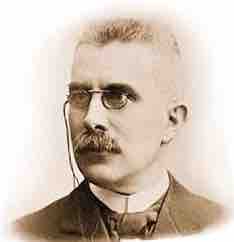Le Chatelier's principle is an observation about chemical equilibria of reactions. It states that changes in the temperature, pressure, volume, or concentration of a system will result in predictable and opposing changes in the system in order to achieve a new equilibrium state. Le Chatelier's principle can be used in practice to understand reaction conditions that will favor increased product formation. This idea was discovered and formulated independently by Henri Louis Le Chatelier and Karl Ferdinand Braun.

Henry Le Chatelier
A photograph of Henry Le Chatelier.
Changes in Concentration
According to Le Chatelier's principle, adding additional reactant to a system will shift the equilibrium to the right, towards the side of the products. By the same logic, reducing the concentration of any product will also shift equilibrium to the right.
The converse is also true. If we add additional product to a system, the equilibrium will shift to the left, in order to produce more reactants. Or, if we remove reactants from the system, equilibrium will also be shifted to the left.
Thus, according to Le Chatelier's principle, reversible reactions are self-correcting; when they are thrown out of balance by a change in concentration, temperature, or pressure, the system will naturally shift in such a way as to "re-balance" itself after the change.
This can be illustrated by the equilibrium of this reaction, where carbon monoxide and hydrogen gas react to form methanol:
Suppose we were to increase the concentration of CO in the system. By Le Chatelier's principle, we can predict that the amount of methanol will increase, thereby decreasing the total change in CO. If we add a species to the overall reaction, the reaction will favor the side opposing the addition of the species. Likewise, the subtraction of a species would cause the reaction to fill the "gap" and favor the side where the species was reduced.
This observation is supported by the collision theory. As the concentration of CO is increased, the frequency of successful collisions of that reactant would increase as well, allowing for an increase in the forward reaction, and thus the generation of the product. Even if a desired product is not thermodynamically favored, the end-product can be obtained if it is continuously removed from the solution.
Changes in Pressure
A change in pressure or volume will result in an attempt to restore equilibrium by creating more or less moles of gas. For example, if the pressure in a system increases, or the volume decreases, the equilibrium will shift to favor the side of the reaction that involves fewer moles of gas. Similarly, if the volume of a system increases, or the pressure decreases, the production of additional moles of gas will be favored.
Consider the reaction of nitrogen gas with hydrogen gas to form ammonia:
Note the number of moles of gas on the left-hand side and the number of moles of gas on the right-hand side. When the volume of the system is changed, the partial pressures of the gases change. If we were to decrease pressure by increasing volume, the equilibrium of the above reaction would shift to the left, because the reactant side has greater number of moles than the product side. The system tries to counteract the decrease in partial pressure of gas molecules by shifting to the side that exerts greater pressure.
Similarly, if we were to increase pressure by decreasing volume, the equilibrium would shift to the right, counteracting the pressure increase by shifting to the side with fewer moles of gas that exert less pressure.
Lastly, for a gas-phase reaction in which the number of moles of gas on both sides of the equation are equal, the system will be unaffected by changes in pressure, since
Addition of an Inert Gas
What would happen to the equilibrium position of the reaction if an inert gas, such as krypton or argon, were added to the reaction vessel? Answer: nothing at all. Remember that the system will always shift so that the ratio of products and reactants remains equal to Kp or Kc. An inert gas will not react with either the reactants or the products, so it will have no effect on the product/reactant ratio, and therefore, it will have no effect on equilibrium.
Changes in Temperature
The effect of temperature on equilibrium has to do with the heat of reaction. Recall that for an endothermic reaction, heat is absorbed in the reaction, and the value of
For an exothermic reaction, the situation is just the opposite. Heat is released in the reaction, so heat is a product, and the value of
If we picture heat as a reactant or a product, we can apply Le Chatelier's principle just like we did in our discussion on raising or lowering concentrations. For instance, if we raise the temperature on an endothermic reaction, it is essentially like adding more reactant to the system, and therefore, by Le Chatelier's principle, the equilibrium will shift the right. Conversely, lowering the temperature on an endothermic reaction will shift the equilibrium to the left, since lowering the temperature in this case is equivalent to removing a reactant.
For an exothermic reaction, heat is a product. Therefore, increasing the temperature will shift the equilibrium to the left, while decreasing the temperature will shift the equilibrium to the right.
Example
In which direction will the equilibrium shift if the temperature is raised on the following reaction?
Our heat of reaction is positive, so this reaction is endothermic. Since this reaction is endothermic, heat is a reactant. By Le Chatelier's principle, increasing the temperature will shift the equilibrium to the right, producing more NO2.